ISSN ONLINE(2319-8753)PRINT(2347-6710)
ISSN ONLINE(2319-8753)PRINT(2347-6710)
Mr. Vishwanath .H. H1, Dr. Thammaiah Gowda 2, Mr. Ravi S.D3,
|
| Related article at Pubmed, Scholar Google |
Visit for more related articles at International Journal of Innovative Research in Science, Engineering and Technology
Steam generators are very complex class of pressure vessels. It contains many accessories for the generation of required steam quality. The prime motto of industrial steam generator is to generate steam at medium pressure (MP), low pressure (LP) steam at required pressure temperature and quantity for the process industry like sugar, paper, jute and chemical industries. LP and MP steam after expansion in the turbine from super saturation is utilized by process industry. In the present work Air Preheater, one of the accessories of the steam generator is analysed. Air preheaters make a considerable contribution to the improved overall efficiency of fossil-fuel-fired power plants. In this study, a theoretical design of Recuperative Primary Air preheater with In-line tube arrangement and a combination of fluid dynamics analysis with theoretical value. The model enables heat transfer of the flue-gas flow through the air preheater as well as the tubular heat transfer and the resulting temperature distribution in the matrix of the preheater. The present work is carried in Mysore Paper Mills (MPM) Bhadravathi, CFD (Computational Fluid Dynamics) analysis of recuperative air preheater is carried out using ANSYS CFX-12.1.The analysis of flue gas flow phenomenon and air flow phenomenon are discussed using Laminar model, k-ε model, k-ω model and SST model. The parameters like temperature distribution, heat flux, pressure drop, velocity, are also discussed. An increase of 2.7% in boiler efficiency was found out with incorporation of this design, their by an increase in the air inlet temperature of about 60℃ is been observed.
Keywords |
| Recuperative Air preheater, k-ε model, k-ω model, SST model, heat flux, In-line tube arrangement. |
Nomenclature |
| Vg velocity of flue gas |
| Cpg Specific heat of gas |
| Cpa Specific heat of air |
| sT Transverse pitch |
| sL Longitudinal pitch |
| do Outer diameter of the tube |
| t tube thickness |
| di Tube inside diameter |
| U Overall heat transfer co-efficient |
| Ft Temperature correction factor |
| LMTD log mean temperature difference |
| Gr Gas film resistance |
| Ar Air film resistance |
| tm Metal temperature |
I. INTRODUCTION |
| The Mysore Paper Mills Limited, (MPM) founded by Sri.Krishnaraja Wodeyar bhadur in 1937 the Maharaja of erstwhile Mysore State was incorporated on 20th May 1936 under the then Mysore Companies Regulation, VIII of 1917. Later it became a Government Company in 1977 under Section 617 of the Companies Act, 1956. The Company Has Its Registered Office At Bangalore And Its Plant Located At Bhadravathi. In India 65 percent of energy consumption due to coal fired power generation is dependent on non-coking coal as high ash coal in pulverized form. The total coal consumed for power generation accounts 50% of the coal produced in India including middling‟s and sinks available from more than 17 Washeries. The quality of Indian coals available for power generation is progressively detoriating with growing emphasis on open cast mining. The high ash content along with highly abrasive nature of the ash causes forced outage of thermal power plants. The average national availability of thermal power plant is between 52 – 53 percent. The existing coal based power plants have reached 36% efficiency. In future program degradation in quality of coal will cause further reduction of the efficiency of power generation as well as inherent creation of pollution problems. Besides pollution caused by the thermal power station is expected to increase its planned addition of power generation capacity. A primary air heater is a tubular, In-line tube arranged air heater. This is arranged in the form of cross-flow heat exchanger. Many primary air heaters are used in coal-fired power plants. In MPM the plant is operating without Air preheater, here the atmospheric air is being fed into the plant. The objective of this work is to investigate the performance of primary air heaters at Mysore Paper Mills Ltd, design & analysis of Recuperative air preheater using CFD. Computational fluid dynamics (CFD) is a computer based tool for simulating the behavior of systems involving fluid flow, heat transfer and other related physical processes. It works by solving the equations of the fluid flow (in a special form) over a region of interest, with specified (know) conditions on the boundary of that region. Fluid (gas and liquid) flows are governed by partial differential equations which represent Conservation laws for the Mass, Momentum, and Energy. Computational Fluid Dynamics (CFD) is the art of replacing such PDE systems by a set of algebraic equations which can be solved using digital computers. |
| The work in this paper is divided in two stages. 1).Theoretical design of Primary air preheater. 2) CFD analysis using theoretical value. Paper is organized as follows. Section II describes Different author‟s point of view and their research work. After discussion of literature view problems justifications have been done. Detailed theoretical design of Tubular primary air preheater, Geometry modelling and meshing is discussed in Section III, IV. Section V presents the post processing i.e. results and discussion. Finally, Section VI presents conclusion, |
II. LITERATURE REVIEW |
| P.N.Sapkal, et.al. Presents an approach for the optimisation of air preheater design with inline & staggered tube arrangement. Air preheaters are designed to meet performance requirements with consideration of highly influencing parameters viz. heat transfer, leakage and pressure drop. The performance of tubular air preheater is evaluated with the help of CFD analysis for In-line & staggered tube arrangement with the latter being more thermally efficient. Thawan Sucharitakul et.al,. studies the performance of cross-flow heat exchanger, known as the primary air heater in a 300 MW lignite-fired power plant under particulate, no leakage, and leakage conditions. The leakage values of selected primary air heater were 6.31, 7.37, and 7.65 % when the power plant was run at the manufacturer guaranteed turbine generator capacity of 100, 80, and 60 % respectively. Under these conditions, the gas side efficiency of the selected primary air heater was found to be at the low level of 66.83, 65.44, and 62.12 % and X-ratios were 0.92, 0.88, and 0.79 respectively. Rakesh Kumar, here the performance of regenerative air pre heater has been evaluated at off design conditions. To assess the performance at different operating conditions and leakage rate, a regenerator leakage model is proposed. The performance improvements of existing non-performing air preheaters are discussed in brief. The performance improvement by improving element profile at cold end of an existing air preheater has been presented. With the change in element profile at cold end air side temperature can be increased up to 10℃and gas side temperature can b e reduced up to 8.5℃. Bostjan Drobnic, et.al. They used a combination of fluid dynamics and a newly developed three-dimensional numerical model for heat transfer as the basis for a theoretical analysis of a rotary air preheater. The model enables studies of the flue-gas flow through the preheater and the adjoining channels as well as the regenerative heat transfer and the resulting temperature distribution in the matrix of the preheater. In MPM they are operating the boiler with out air preheater, from literature review it is found out that for every 20℃ rise in combustion air the efficiency of the boiler will increase by 1%. Reduction of flue exit temperature will also helps in reduction of harmful gases up to certain extent, also results in lesser coal consumption. |
III. METHODOLOGY |
Theoretical Tubular Primary air preheater Design |
 |
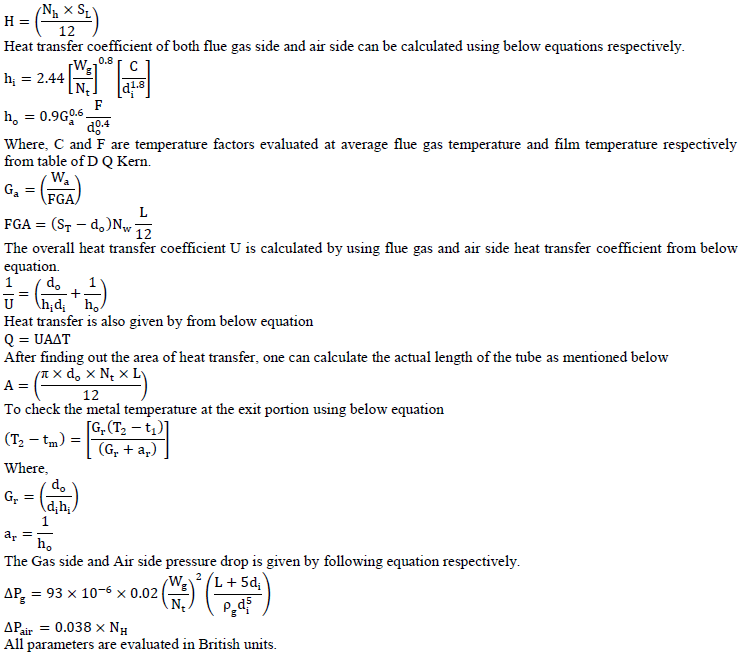 |
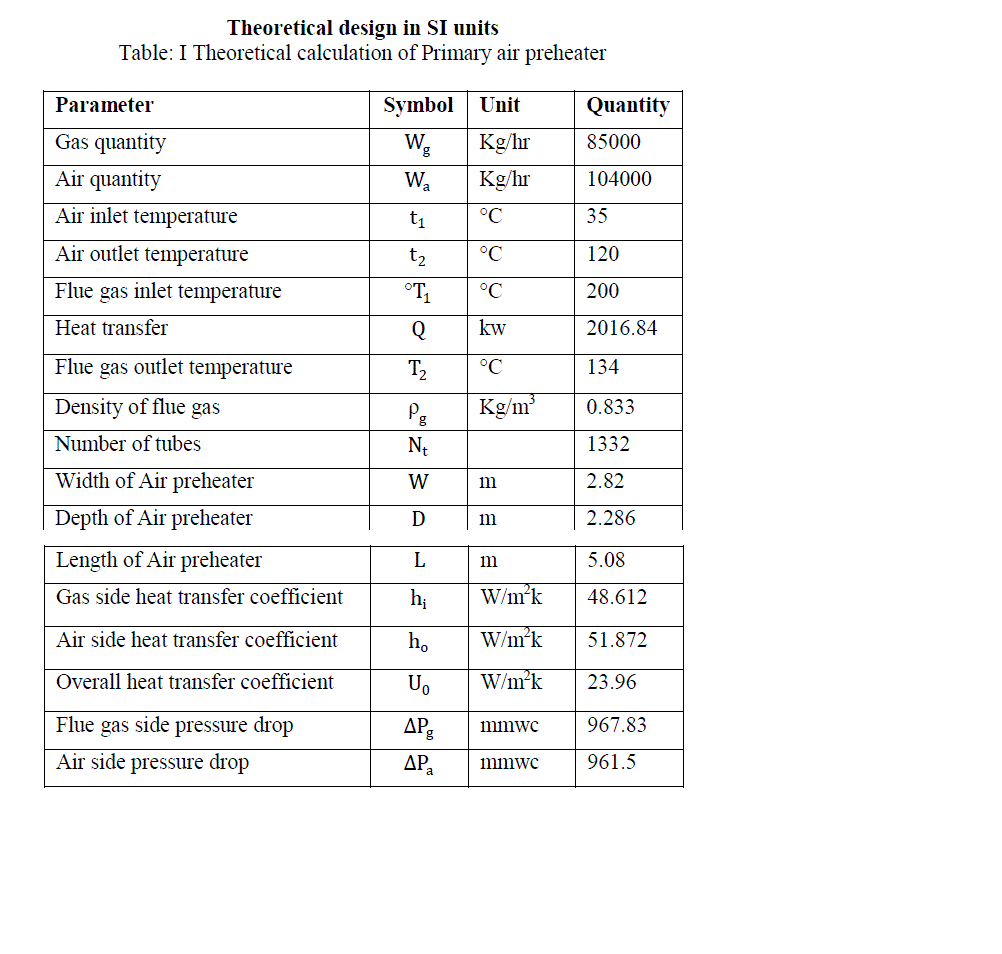 |
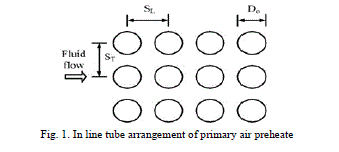 |
IV. GEOMETRY MODELING AND MESHING |
| The geometric modeling of heat exchanger was built in ICEM CFD on same grounds as in experimental study. Since flow around heat exchanger and inside the tubes have scaled down from 1332 tubes matrix to the 9 tubes matrix with 3 rows and 3 columns. The HX domain is in rectangular in shape, to reduce the computational domain this scaled down approach is been selected. The simulation done on a scaled down model of the heat exchanger would imply to the whole domain. So scaled down model of heat exchanger was built in ICEM CFD. Heat exchanger model can be seen in Fig.2a. Time tubes and flow rates are scaled down the full model including ducts. The heat exchanger tubes are considered structured mesh and around the tubes have considered unstructured meshes for geometry. It was not possible to create hexahedral volumes in heat exchanger model around the tubes volumes. So an unstructured mesh was generated using robust volume meshing. The Robust Volume Meshing method produces a triangular or quadrilateral volume meshes. The volume mesh is produced interactively and can contain many different element types, including hexahedral and wedge elements. The mesh has been clustered more at wall of the heat exchanger to capture boundary layer growth near the wall. Grid refinement study was carried out in order to see if flow captured is sensitive to grid distribution, it can be seen from fig 2b&c. Refining grids beyond 12.5 lakhs elements does not alter the results by more than 2 % and hence results at this grid resolution are optimum to predict flow in heat exchanger accurately. |
Boundary conditions |
| Any numerical simulation can consider only a part of the real physical domain or system. Furthermore, walls that are exposed to flow represent natural boundaries of physical domain. The numerical treatment of boundary conditions requires a particular care. Stability and convergence speed of solution scheme can be negatively influenced. Steady state approach with stationary domain, non-buoyant condition, low intensity turbulence and static temperature of 300 K are used as criterion for solution. Air at 250 C and Flue gas are used as domain fluid and reference pressure is taken as 1 ambient. „No slip‟ conditions are used at the wall. The upwind advection scheme is used and a very small physical timescale is specified. The flow models used is SST. Fig2d shows the boundary representations, white color arrows are inlets and yellow color arrows represents. |
V. RESULTS AND DISCUSSION |
| Numerical analysis is carried out for heat exchanger using counter flow approach. Ansys CFX 12.0 is been used for simulate the HX process in the selected HX domain. Geometrical configurations are shown in the geometry and meshing part. The cold air is entering into the domain with ambient condition at 35 C, and hot flue gas will enter into the tubes bundle domain with hot condition at 200 C. Flue gas is the mixture of CO2 and N2. |
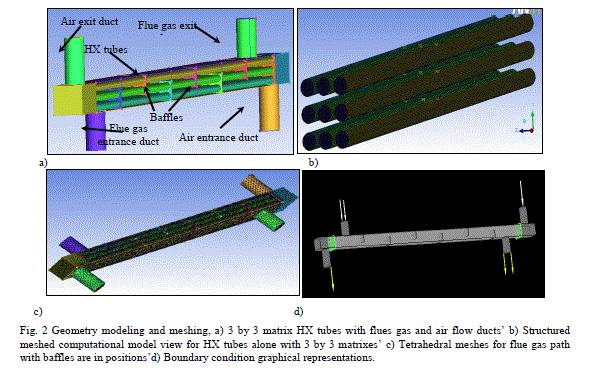 |
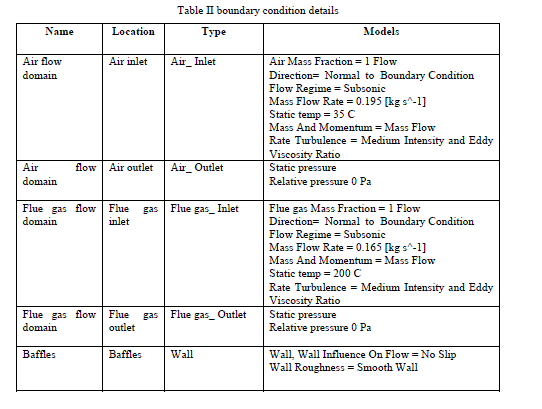 |
| CFD modeling is done as like test setup condition and heat transfer is also enabled in the simulation. Heat transfer option is Thermal energy used with omega based SST turbulence model is used to resolve the near wall heat transfer coefficient effectively. In the actual setup there are 1332 HX tubes with big compartment, for simulation simplification 9 HX tubes are selected by 3 × 3 matrix. It is been scaled down by geometrically, dynamically and kinematical. The scaled down ratio is 148 times as compared to the test model. This modeling scaled down model itself called for 12.5 lakhs computational mesh elements. Inner core of the tubes are considered structured meshes and tubes thickness is also structured mesh. The baffles and air manifolds are in the modeling and it is little complex to generate the structured mesh apart from the tubes. So unstructured meshes called tetrahedron elements are generated with fine meshes, in which it can able to capture the boundary layers using by prism layers of the unstructured meshed model around the HX tubes. |
Flue Gas flow phenomenon |
| Flow gas enters the domain in tubes location, the temperature of the flue gas is at 200 ℃ when it enters. One can see the velocity vector in below Fig 3a the gas is entering into the tubes domain and passes over the HX tubes. Baffles are hindering the flue gas path and change the flow path for effective heat transfer can be done in this process. Baffles are designed such way that entire length of the tubes has to exchange the heat information by conduction and convection process. |
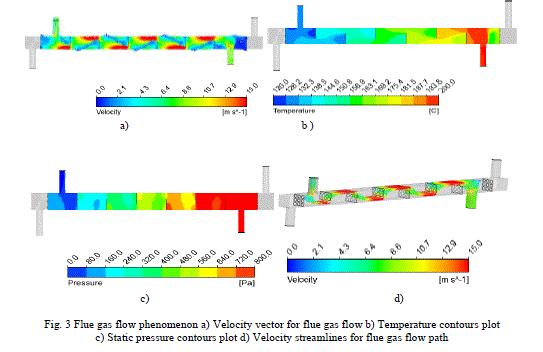 |
| Figure2bshows the temperature variation for flue gas across the fluid domain, when the flue gas enters into the domain the temperature is 200 oC. When the hot gas reached at exit location of the domain temperature brings down to 120o C. Baffles are the good options for increase the heat transfer rate across the domain. Temperature profile can see that the temperature bring down effectively in half of the length of domain. The temperature reduction is 80oC effectively, the calculations are also shows similar range of the temperature data and it is very much closer to the test data. Temperature comparisons can be seen in summary part of the report. The flue gas is a combination of CO2 and N2. Figure.5c shows the static pressure variation across the flue gas domain. The system static for the entire domain is offering 800 Pa its almost 0.2 PSI. The estimated pressure drop is not exceeding beyond the limit and these numbers are expected for this type of fluid domains. Also the pressure variation is uniform across two planes. So this indicates the flow behavior inside the fluid domain remain same even though we select the full geometry. Velocity streamline is shown in figure 2d, from which it can be seen that the velocity of flue gas is increasing at the baffles. |
Air flow phenomenon in the fluid domain |
| Air enters the domain in tubes location, the temperature of the air is at 35℃ when it enters. One can see the velocity vector in below Fig 4a; the air is entering into the tubes from the entrance duct and leaving domain through exit domain. The velocity distribution across tubes is not varied much. Velocity of air is same at inlet and outlet of the domain. Fig 4b shows the temperature variation for airflow across the fluid domain, when the air enters into the domain the temperature is 35oC. When the hot air reaches the exit location of the domain, temperature shoots up to 95oC. Temperature profile can see that the temperature shoots up in half of the length of domain. The temperature rise is 60oC effectively, the calculations are also shows similar range of the temperature data and it is very much closer to the test data. |
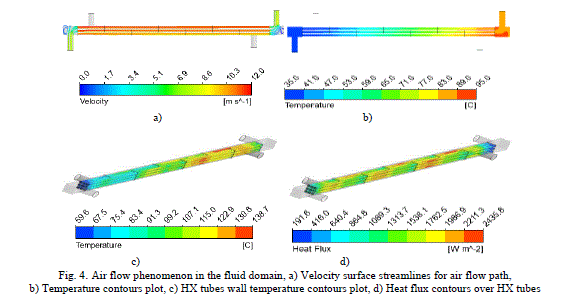 |
Result table |
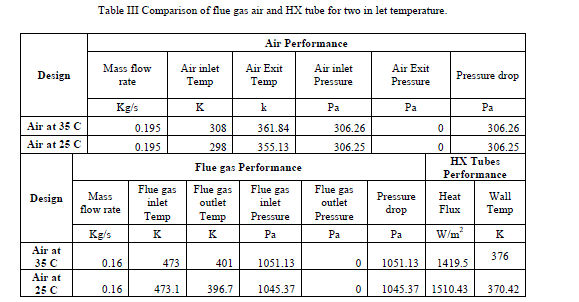 |
| Temperature on HX tubes are shown in below fig 4a) air entrance side of the tubes has low temperature region, it is about 60 C. The flue gas looses the enthalpy when its reach the exit of the domain, due to this reason the low temperature is captured. The high temperature over HX tubes captured where the flue gas enters the domain. And we can see that the baffles are changing the flue gas flow directions, due to the change in direction the temperature profile over HX tubes are changing. Heat flux on HX tubes are shown in below fig 4b) flue gas entrance side of the tubes has low heat flux region is captured. Once enter the flue gas inside, the tendency of hot fluid take a turn towards baffles side and right side has little recirculation flow. Due to the flow turn the heat transfer rate is less in that location. Other places of tubes have better heat transfer. |
VI. CONCLUSION |
| The heat transfer, temperature variation, velocity of both flue gas and air and heat flux is reported in this study. From fig 3(a, b) the baffles are providing the hindrance to the flow path of flue gas, so that the maximum heat flux is observed at this point of HX tubes it can be seen from fig 4d So it can be concluded that by providing baffles the rate of heat transfer will be increased. An optimum air side pressure drop is observed, which depicts the installation of medium quantity of air blower, by which energy consumed will be less, from that the overall efficiency of the plant will increase. From incorporating the proposed design in the existing plant, the temperature of the primary air would increase by about 60oC. Then the efficiency of the boiler would increase by 2.7%, their by reducing the coal consumption. |